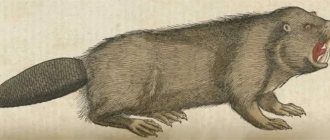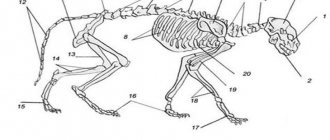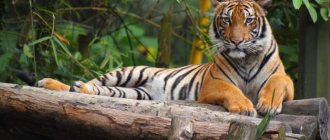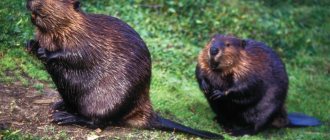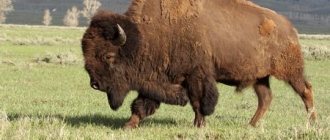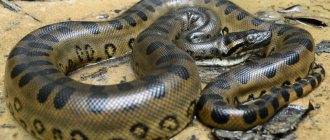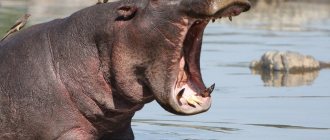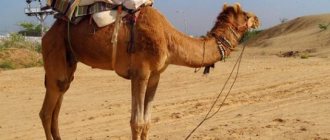Diplodocus was one of the largest dinosaurs. This giant occupied quite a lot of space in prehistoric forests. He could not move quickly, although he did not need to: an adult diplodocus was so huge that almost no predator dared to attack him.
Today, Diplodocus is considered one of the most famous and well-studied ancient dinosaurs. Copies of his skeleton are exhibited in many parks and museums around the world. The head of the lizard is very small compared to the body. Massive straight legs look like columns. The forelimbs of the lizard were shorter than the hind limbs.
The weight of Diplodocus is greatly exaggerated
Despite its impressive size and enormous length, Diplodocus was quite slender compared to other Late Jurassic sauropods. The maximum weight could have been "only" 20-25 tons, significantly less than their contemporary, the 50-ton Brachiosaurus. However, it is possible that some individuals weighed about 30-50 tons. Paleontologists also identify a group of 100-ton seismosaurs, which could be a type of diplodocus.
Reproduction and offspring
Most likely, the female Diplodocus laid her eggs (each about the size of a football) in shallow holes that she dug on the edge of the rainforest. Having laid the eggs, she covered the eggs with sand/earth and calmly moved away, that is, she behaved like an ordinary sea turtle.
True, unlike turtle offspring, newborn diplodocus did not rush to the saving water, but to the tropics to hide from predators in dense thickets. Seeing a potential enemy, the cubs froze and practically merged with the bushes.
This is interesting! From histological analyzes of bone tissue, it became clear that diplodocus, like other sauropods, grew at a rapid pace, gaining 1 ton per year and achieving fertility after 10 years.
Return to content
Diplodocus's front legs were shorter than its hind legs
All Jurassic sauropods were similar in many ways, except for some differences. For example, the front legs of Brachiosaurus were significantly longer than its hind legs. Its complete opposite was Diplodocus. The low posture of this sauropod lends weight to the theory that Diplodocus fed on the foliage of low-growing trees and shrubs rather than eating the tops of tall trees, although this may not have been the only reason for this adaptation. Perhaps this body structure was associated with the mating characteristics of diplodocus, about which we know very little.
Diplodocus lunch
Surprisingly, Diplodocus's teeth were better suited for chewing low-growing ferns rather than foliage from treetops. This ability was very useful for the dinosaur, because in order to feed the huge carcass, it was necessary to eat a huge amount of plant food every day. Diplodocus was drawn not only to tree foliage, but also to low-growing plants. Along the way, the lizard swallowed stones, which helped to grind and grind kilograms of plants eaten per day in the stomach.
The neck and tail of Diplodocus consisted of almost 100 vertebrae
Most of Diplodocus's length came from its neck and tail, which were slightly different in structure. This dinosaur's neck consisted of only 15 elongated vertebrae, while its tail consisted of 80 much shorter vertebrae. This large number of bones likely allowed Diplodocus to use its tail not only as a counterweight for its neck, but also as a whip as a weapon against predators. Although there are not enough findings to confirm this hypothesis.
Flexible tail
The tail of Diplodocus consisted of 70-80 vertebrae. Its end was quite thin, so that the dinosaur, with the help of powerful muscles, could swing it like a whip to protect itself from enemies. Considering the enormous mass of the tail, such blows were very dangerous even for large predators. Diplodocus raised its tail when walking, rather than dragging it along the ground.
Most Diplodocus skeletons are gifts from Andrew Carnegie
In the early 20th century, steel magnate Andrew Carnegie donated complete casts of Diplodocus skeletons to various European monarchs, resulting in life-size Diplodocus “skeletons” appearing in many museums. Such exhibits are on display at the Natural History Museum in London, the Museo de la Plata in Argentina, and, of course, the Carnegie Museum of Natural History in Pittsburgh (this exhibit is made up of original bones, not plaster reproductions). By the way, Diplodocus himself was named not by Carnegie, but by the famous 19th century paleontologist Othniel Marsh.
Discovery History
The first fossils of Diplodocus date back to 1877, thanks to the efforts of Benjamin Moge and Samuel Williston, who found vertebrae near Canon City (Colorado, USA). The following year, an animal unknown to science was described by Yale University professor Othniel Charles Marsh, giving the species the name Diplodocus longus. The middle fragment of the tail was distinguished by an unusually shaped vertebra, due to which Diplodocus was awarded its current name “double beam”.
Later, a partial (without skull) skeleton found in 1899, as well as a skull discovered in 1883, were assigned to the species Diplodocus longus. Since then, paleontologists have repeatedly found fossils of diplodocus, including them in different species, the most famous of which (due to the integrity of the skeleton) was Diplodocus carnegii, found in 1899 by Jacob Wortman. This specimen, 25 m long and weighing about 15 tons, received the nickname Dippy.
This is interesting! Dippy was distributed worldwide with 10 cast copies placed in several major museums, including the St. Petersburg Zoological Museum. Andrew Cornegie presented a “Russian” copy of Diplodocus to Tsar Nicholas II in 1910.
The first remains of Diplodocus hallorum were found in 1979 in New Mexico and were mistaken by David Gillette for the bones of a seismosaur. The specimen, consisting of a skeleton with fragments of vertebrae, ribs and pelvis, was erroneously described in 1991 as Seismosaurus halli. And only in 2004, at the annual conference of the Geological Society of America, this seismosaur was classified as a diplodocus. In 2006, D. longus was equated to the species D. hallorum.
The most recent skeleton was found in 2009 near the town of Ten Sleep (Wyoming) by the sons of paleontologist Raymond Albersdorfer. The excavation of the diplodocus, nicknamed Misty (short for Mysterious, “mysterious”), was carried out by the organization Dinosauria International, LLC.
It took 9 weeks to extract the fossils, after which they were sent to the central fossil processing laboratory located in the Netherlands. The skeleton, assembled from 40% of the original bones of a young Diplodocus, 17m long, was then transported to England to be auctioned at Summers Place (West Sussex). On November 27, 2013, Misty was purchased for £488,000 by the Natural History Museum of Denmark, based at the University of Copenhagen.
Return to content
Diplodocus probably did not raise its long neck high above the ground
Paleontologists have difficulty reconciling the possible cold-bloodedness of sauropod dinosaurs with the idea that they held their necks high above the ground. Having to pump blood 10-12 meters high thousands of times every day would put enormous strain on the heart. A common hypothesis today is that Diplodocus kept its neck parallel to the ground in order to feed on low vegetation. Proof of this is the unusual shape and arrangement of teeth and the lateral mobility of his huge neck.
Structural features
Diplodocus had a small skull with a poorly developed jaw. Peg-shaped teeth were located on its front part, creating the effect of a comb - this made it more convenient for the dinosaur to pick off the plants it was eating. The nostrils were next to the eyes. For some time, scientists believed that this gave Diplodocus the ability to breathe underwater. Later they abandoned this hypothesis.
Scientists have calculated: taking into account the length of the neck, the heart of Diplodocus must have weighed at least 1.5 tons. Perhaps it had several small
Possibly Diplodocus and Seismosaurus belonged to the same species
It is often difficult to distinguish between different genera, species and individuals of sauropods. An example is the long-necked seismosaur, which, according to some paleontologists, should be classified as an unusually large species of diplodocus, Diplodocus hallorum. Wherever it was placed on the sauropod family tree, Seismosaurus was a true giant, measuring over 30 meters from head to tail and weighing up to 100 tons, matching the weight class of the largest titanosaur of the subsequent Cretaceous period.
Diplodocus species
There are now several known species belonging to the genus Diplodocus, all of which are herbivores:
- Diplodocus longus is the first species discovered;
- Diplodocus carnegii - described in 1901 by John Hatcher, who gave the species name in honor of Andrew Carnegie. The species became famous thanks to its almost complete skeleton, which was copied by many international museums;
- Diplodocus hayi - partial skeleton found in 1902 in Wyoming, but described only in 1924;
- Diplodocus hallorum - first erroneously described in 1991 by David Gillette under the name "seismosaur".
All species belonging to the genus Diplodocus (except the last one) were classified between 1878 and 1924.
Return to content
An adult Diplodocus had no natural enemies
Given its enormous size, it is extremely unlikely that predators would attack a healthy adult 25-ton Diplodocus even if they were in a school. Most likely, Late Jurassic predators would have attacked egg clutches, as well as young and juveniles of this sauropod. Surely, very few newborn diplodocus survived to adulthood. Allosaurus may have been able to attack adults only if they were sick and thus were more likely to lag behind the herd when bleeding.
Lifestyle
Diplodocus gathered in herds of 20 to 30 individuals. They did not have a pronounced parental instinct. Females laid eggs on the edges of the forest in specially dug holes. At first, the cubs lived in the forest, hiding in dense vegetation from predators. Having matured, they went out into more open space, gradually forming new herds.
It is assumed that adult diplodocus rarely became victims of predators, since they could seriously injure the attacker with blows of the tail or simply trample him, taking advantage of their advantage in size. Mostly young individuals were attacked - they were no longer hiding in the forest, but were still not large enough to scare away enemies. The diet of diplodocus consisted of foliage, coniferous plants and, possibly, algae. The menu of adults and cubs was different: the former ate greens from tall and medium-sized trees, the latter obtained food by plucking low-growing bushes.
In the footsteps of diplodocus
Alexander Tolmachev
Aug 19, 2021·6 min read
Where and when
Diplodocus lived at the end of the Jurassic period about 154–150 million years ago. They were distributed throughout the United States of America (Colorado, Utah, Wyoming, Montana and New Mexico).
How did he become famous?
Carnegie's Diplodocus became one of the most famous dinosaurs thanks to Andrew Carnegie. Steel industrialist and philanthropist Andrew Carnegie, interested in the 1899 find, organized an expedition at his own expense, the leadership of which was entrusted to paleontologist Jacob Wortman. On July 4, 1899, after three months of searching and unsuccessful excavation, the first skeleton (CM 84) of a new species of Diplodocus was found, which was later named "Carnegie's Diplodocus" in honor of Andrew Carnegie, who financed the excavations. One of the copies was donated to Russia. In 1910, it was installed in the Zoological Museum of St. Petersburg, and with the opening of the new building of the Paleontological Museum, it was transported to Moscow.
Where did you live?
They lived mainly in swampy areas, coming onto land only to eat leaves and other vegetation, and also to lay eggs.
Body structure
The body length of this Late Jurassic sauropod reached as much as 33.5 meters (species Diplodocus hallorum, previously considered a seismosaur)! The height is up to 10 m. Despite the incredible length, they had a lightweight skeleton and therefore weighed relatively little - up to 38.8 tons.
The largest were 36m in length, the average length was 26–27m
It was 14–15m in height
Body weight - from 18 to 75t
They weren't that clumsy - just look at the structure of the spine. Evolution has done an amazing job of making the skeleton easier to construct. An additional argument is that most of the length came from the thin tail and neck. The whole body was equipped with the corresponding muscular system. Of course, diplodocus were hardly capable of running, but in general they were much faster and more maneuverable than many of their fellow sauropods (for example, brachiosaurs).
Diplodocus could reach such a height thanks to its powerful spinal muscles, many times more powerful than the pumped up muscles of weightlifters and bodybuilders.
Looks like a very heavy neck and tail!
What did nature invent to make the Diplodocus's huge neck and tail lighter? This adaptation is found in modern birds.
The neck and tail bones of Diplodocus were hollow. Diplodocus had a long neck consisting of 15 vertebrae, possibly filled with communicating air sacs.
Legs and claws on the front legs
There were 4 of them, they were very powerful and strong, because it would be impossible to support such a huge body mass on small and weak legs; the hind legs were slightly longer than the front ones. On which there were claws that could injure any predator.
Why was it important for Diplodocus to stand on its hind legs?
Most likely, he could stand on his hind legs and then reach the juiciest, sun-kissed leaves.
The diplodocus's formidable weapon was also the large claws on its front legs. By rearing up and leaning on its tail, Diplodocus could simply trample its attacker. Given the size of the dinosaur, it can be assumed that adult diplodocus had no enemies.
Head
It was very small, like his brain (no larger than the size of a chicken egg), especially if you look at his body, it was held on the neck (7.5–8 m). The nostrils were located near the eyes, and not as we are usually used to (at the end of the muzzle).
There was no second brain
Myth: Paleontologists named this lizard-hipped dinosaur Diplodocus because it had a second brain at the end of its back, in the sacrum. It would be very tempting to assume that this brain “commanded” the tail, especially since it was even larger than the head.
In fact: It is clear that no one has ever seen any brain in dinosaurs - neither the head nor the “back”: paleontologists have only fossilized skeletons at their disposal, showing that in the pelvic area some dinosaurs had an expansion of the spinal canal. If it were filled with ordinary nervous tissue, its volume would exceed the volume of the brain by 20 times. But unlike the author of the “hindbrain” hypothesis, the 19th-century American researcher Othniel Marsh, modern paleontologists tend to believe that the cavity did not contain the brain, but the so-called glycogen body, also found in birds - direct descendants of dinosaurs. The glycogen body consists of nerve cells containing a large supply of the polysaccharide glycogen. Thus, it is not a brain, but rather an additional source of energy for the nervous system.
The jaws were poorly developed, the teeth were short and more intended for picking greenery than for chewing it, so while eating food, the dinosaur also swallowed stones in order to grind the accumulated food in the stomach. Plus, the teeth were not quite evenly spaced.
Tail
The huge tail served for protection and communication in the flock. It consisted of 70 vertebrae and was very mobile.
Nutrition
It is believed that diplodocus led a gregarious lifestyle, evidence of which is provided by group footprints.
The diplodocus plucked tree branches with its small head. Diplodocus also fed on aquatic plants, while swallowing small aquatic animals (mollusks, small arthropods, insect larvae, etc.).
They had a gregarious lifestyle; they ate young shoots, cones, tree leaves and pine needles; they also ate seafood (shellfish, small squid, algae).
It is known that Diplodocus was a herbivorous dinosaur, but the structure of the jaws and teeth causes debate among scientists about what the dinosaur actually ate. The jaws were poorly developed, and with such a tooth structure, Diplodocus could hardly chew food. It is most likely that diplodocus plucked leaves and shoots of ferns and low-growing plants and simultaneously swallowed stones that helped them with digestion. Diplodocus could also feed on algae and at the same time swallow small mollusks.
How do scientists know that diplodocus lived in open areas and did not hide from predators in the forest?
Diplodocus mostly lived in swampy areas and were excellent swimmers. They came to land to lay eggs and eat food. The eggs were not large in size, the same as today's basketballs.
Laying eggs
Diplodocus are huge dinosaurs, but their eggs are no bigger than a football. The cubs hatched tiny, but due to their size, adult diplodocus were unable to care for their offspring. The herds constantly moved in search of food. The female Diplodocus laid many eggs on the outskirts of the forest and buried them. After which she left and never returned.
What modern animals also bury their eggs and never return to lay them?
The little diplodocus had no protection. How could they protect themselves from large predators like Allosaurus without starving to death?
Allosaurus averages 8.5 meters in length, 3.5 meters in height
When the little sauruses hatched, they tried to hide in the thicket of the forest so that predators would not feast on them. But when they grew up, not a single predator could resist this colossus; only a flock of predators could defeat them.
Enemies
Allosaurus and Ceratosaurus
Self defense: tail
In case of attack by predators, the main weapon was the whip-like tail.
Ceratosaurus
Typical theropod
Ceratosaurus was a large bipedal dinosaur with powerful hind limbs and reduced forelimbs. The length of the skeleton of the largest specimen of ceratosaurus found is estimated at approximately 7 m. Weight, according to various estimates, varies greatly: from 275 to 980 kg for different specimens.
A distinctive feature of the anatomy of Ceratosaurus was the relief horn on the nasal bones of the skull, from which the lizard got its name, as well as two horny protrusions. More than half of the teeth of the upper jaw were very long and strong; the teeth of the lower jaw were smaller and less strong. Along the midline of the back, the skin of ceratosaurs was covered with a number of osteoderms.
Ceratosaurs lived near rivers, lakes and swamps, often going into the water and hunting aquatic animals: fish, crocodylomorphs and turtles. However, they could diversify their diet with the meat of larger terrestrial herbivores, while participating in competition with allosaurs.
Extinction
Diplodocus, like many other large dinosaurs, went extinct at the very end of the Jurassic period - about 150 million years ago. The reasons may vary. Either these are some kind of environmental changes in the area where diplodocus lived, or the food supply has decreased and the giant dinosaurs simply have nothing to eat.
What other very large ancient animals became extinct because they could not feed themselves?
Mammoths and megalodons - the same fate
But perhaps their disappearance is due to the emergence of new predators that preyed on the young.
Popular message topics
- Vector Graphics
To understand vector graphics, you need to understand the two most common graphic design image files: raster and vector. - Aster Flower
The ideal garden flower is the aster. This flower is beautiful and does not require special care. These flowers ended up in Europe at the beginning of the 18th century. The first country to be conquered by this flower was France. The aster originally grew in China, - Gods of ancient Egypt
At all times, people from different countries, experiencing joyful or sad events, tried to associate them with the manifestation of praise or punishment from someone above. The inhabitants of Egypt had their own ideas about retribution for weaknesses. They either felt like sinners
Description: A giant lizard from the distant past
Diplodocus is considered the most famous prehistoric reptile. This is a herbivorous dinosaur that lived in the late Jurassic period. According to scientists, medium-sized individuals reached 25-27 m in height. At the same time, the most prominent part of his body was the massive neck on which his small head rested.
The hind limbs of the reptile were longer than the front ones, so the center of gravity shifted and the body always leaned forward. Because of this specific structure, diplodocus could not escape from the predatory representatives of its era by running. His defense was his tail, which the ancient giant wielded like a whip.
The dimensions of Diplodocus are incredible: up to 54 meters in length, weight could reach up to 113 tons. However, he was not the heaviest representative of the ancient fauna. (see Who are the biggest and smallest dinosaurs in the world?).
Interesting facts about Diplodocus
- Diplodocus were made to look like living suspension bridges, with columnar legs, particularly long necks, and even longer tails that tapered to a point.
- Diplodocus led a unique lifestyle, evidenced by massive footprints.
- The condition of the nasal openings, which are located at the top of the skull, also shows the aquatic way of life of Diplodocus. Diplodocus's nostrils were not located at the end of the snout like other dinosaurs, but were located towards the eyes.
- When the lower tiers of the forest ran out of food for Diplodocus, he could climb on his hind limbs and tear pliable leaves from the tops of trees.
- Based on the numerous prints found, experts concluded that diplodocus lived in herds, somewhat in line with current shoaling animals.
- At 27 m long, the dinosaur was one of the most gigantic dinosaurs.
- In the front of the diplodocus mouth were teeth shaped like pencils. These teeth are not very ready for chewing, so it is possible that diplodocus swallowed pebbles or small stones to improve the digestion of food.
- When attacked by animals, they defended themselves with the help of their tail and front paws with long pointed claws.
